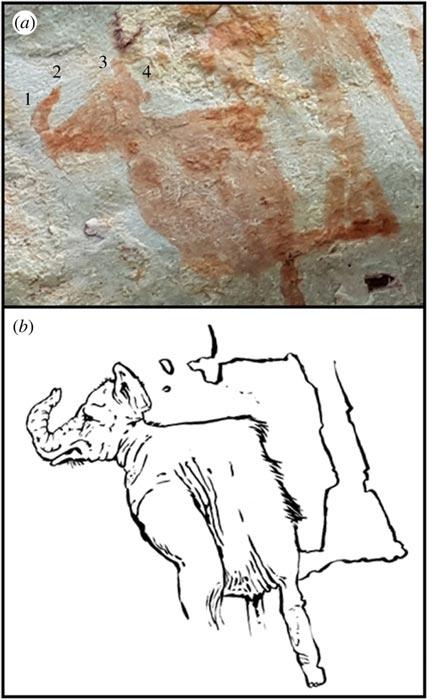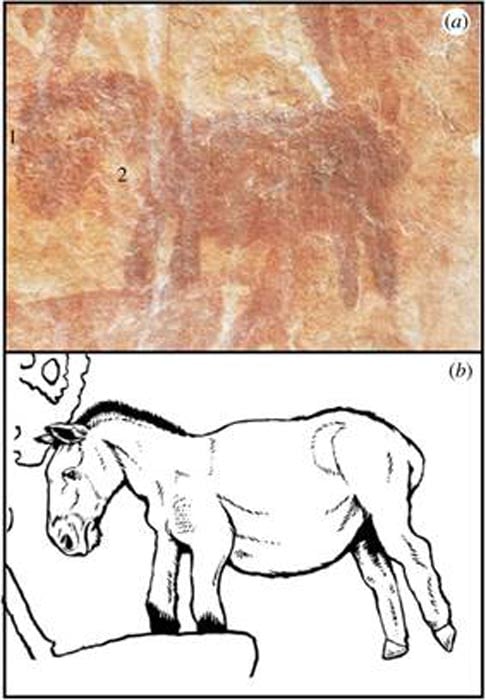Does Amazonian Rock Art 'Sistine Chapel' Depict Ice Age Megafauna?
Earlier this month, the journal Philosophical Transactions of the Royal Society B published detailed analyses and pictures of the spectacular 8 mile (13 km) long rock art mural discovered in the Amazon rainforest in 2016. Dubbed “the Sistine Chapel of the ancients,” the mural is set over three different rock shelters and includes thousands of rock art pictures which were found at Serranía La Lindosa in modern-day Colombia. According to the study, this Amazonian rock art depicts Ice Age megafauna including giant sloths, mastodons, camelids, horses and three-toed ungulates with trunks, to name but a few.

The study claims that the Amazonian rock art includes depiction of a gomphothere, seen here. (Daniel Eskridge / Adobe Stock)
Amazonian Rock Art and Ice Age Megafauna
“(The paintings) have the whole diversity of Amazonia. Turtles and fishes to jaguars, monkeys and porcupines,” said study author Jose Iriarte, a Professor in the Department of Archaeology at the University of Exeter in the United Kingdom, when discussing the Amazonian rock art. “They encountered these large-bodied mammals and they likely painted them. And while we don't have the last word, these paintings are very naturalistic and we're able to see morphological features of the animals.”
- Ice Age Colombian Art Found Painted On Remote Jungle Cliffs
- Aboriginal Australians Co-Existed with the Megafauna for at Least 17,000 Years
Iriarte is referring to those doomed species that didn’t survive the receding of the most recent Ice Age, roughly over 12,000 years ago – these ochre photographs are potentially a documentation of a brief co-existence with humankind. Prehistoric humans allegedly moved into the Amazon region and came into contact with these large megafauna, painting them in response. He finds the paintings and their morphological features very naturalistic, though he does concede that their study does not represent the final word yet, something that others in the scientific community have also pointed out.

Amazonian rock art includes what could be a depiction of a gomphothere. Rock art above and artists reconstruction below. (Iriarte et al. / Royal Society B)
Meet the Naysayers: Scientists Who Are Not Convinced
Professor Ekkehart Malotki, professor emeritus of languages at Northern Arizona University, strongly disagrees. His work has centred on petroglyphs that depict extinct megafauna, and he has called Iriarte and his team “wishful thinkers” in an email exchange with the The New York Times. Terming their approach mere “eyeballing,” he is far from convinced.
Added to the mystery is the condition of the rock art mural, which is so well-preserved that dating it to 12,000 years old seems premature. In fact, Malotki is convinced of a younger origin. Fernando Urbina and Jorge Peña, archaeologists at the Universidad Nacional de Colombia, are in agreement with Malotki.
The Ice Age origin was contested as early as 2016 in their independent research, as they argue that many scenes at La Lindosa might be representations of animals introduced by the Europeans, who arrived in the continent only at the end of the 15th century. These could be capybaras and modern horses which are contrastingly seen by Irierta and his team as potential giant ground sloths and Pleistocene horses! Dr. Urbina is cautious in reserving judgment till scientific dating conducted on the paintings reveals the entire truth.
As per the preliminary dating provided by Irierta and his team, when the drawings were allegedly made, the Amazon basin was undergoing a rapid change. From low lying savannah grasslands, patchy tropical forest, and thorny scrubs, it was metamorphosizing into the broad-leaf moist tropical forests that we recognize it as today, says a report published on CNN.

The study claims that another section of the Amazonian rock art Is a depiction of a horse. Critics are not so sure. (Iriarte et al. / Royal Society B)
Jury Still Out for Amazonian Rock Art
Archaeological evidence pegs the first human settlers around 11,200 years ago, in the throes of the Neolithic revolution that had led to hunter-gatherer communities to begin settled agriculture. This is precisely what Irierta and his team have held on to – the mutual co-existence of human beings and large Ice Age megafauna, as evidenced from archaeological and paleontological evidence. Ochre has also been found in sediments laid down at Colombia’s La Lindosa during the end of the Ice Age, which suggests that the Amazonian rock art could indeed be that old. Contrastingly, animal fossils of the kind in these pictographs have not been found anywhere in the area.
- Ten Mysterious Examples of Rock Art from the Ancient World
- Of Bunyips and Other Beasts: Evidence of Extinct Megafauna Displayed in Art and Stories
“The interpretation of rock art images is always subject to debate, especially when it is argued that extinct animals were depicted,” highlighted Professor Paul Tacon, a professor of archaeology and anthropology at Griffith University in Australia, in The New York Times. “In this case there is a strong argument using multiple lines of evidence to support the contention that some surviving paintings in the Colombian Amazon are of extinct megafauna from the late Pleistocene or early Holocene. The next challenge is to scientifically date the paintings to support or refute this contention.”
There is a unique challenge involved when analyzing this Amazonian rock art. Ochre, an inorganic mineral pigment, is ridiculously difficult to date as it contains no carbon and therefore cannot be carbon dated. The only hope is that the artists from before mixed the ochre with a binding agent of some kind that will allow scientific dating. The results of this are expected sometime later this year.
Top image: Amazonian rock art at the Serranía La Lindosa in Colombia. Source: Iriarte et al. / Royal Society B
By Sahir Pandey




















Comments
I see two brassieres, a giraffe, a giant beaver, and a pair of sunglasses.